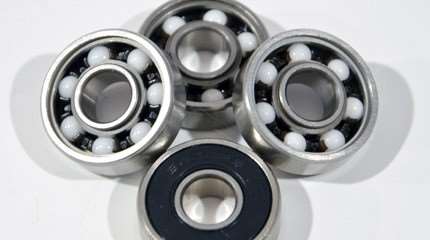Testing the DMB ceramic ball bearings
Winter rain launches the subject of bearing maintenance. In order to reduce the time of dismantling, cleaning, oiling... ceramic bearings quickly come to mind. We bought DMB ceramic ball bearings to see how they put up with bad weather...
Par alfathor

Test bench
The difference between classic and ceramic bearings
In a classic bearing, the cage and the balls are made of chrome steel. In a low-range ceramic bearing, the cage is made of steel or stainless steel and the balls are made of ceramic. Some models are completely made of ceramic but prices soar up to several hundreds of euros for a set. Theoretically, those bearings don’t need much maintenance and have a better water resistance.
Description of the DMB ceramic bearings
The DMB ceramic bearings are 608D’s, which means that they have an elastomer flange on one side only for less friction, but it also means that more dirt will get inside.
The cage contains 7 ceramic balls separated with a nylon part. Spinning them at idle before setting them up, you notice that they are lubricated and make a bit more noise than classic 608 bearings.
Set-up
No problem to insert the bearings into the wheels by hand. You can adjust the whole set-up in placing the wheel on a flat surface and pressing down on it.
Don’t forget to place the side with the flange on the outside!
With use
The feelings conveyed during the tests at idle are confirmed: The DMB ceramic bearings make more noise than classic 608 bearings of good quality. It is not disturbing at first, especially if you skate on smooth surfaces. On the other hand, with time, the lubricant makes its getaway and the bearings start squeaking!
When you dismantle them, you note that they haven’t oxidized (which is a good thing) but that they are dirty (drawback). Due to the lack of denser lubricant to protect the bearings, they gather dust and dirt quickly and, as a consequence, lose in efficiency.
First thing if you buy them: Complete the lubrication with thick gel or fluid grease.
Once lubricated again, our set of bearings became quiet again, even more than when we first bought them.
Wear
After 50 km, the bearings set up at the front wheels are the most damaged. The balls and the cages seem to have become loose. Dirt slows down the rotation at idle. The bearings remain usable for fitness skating or for training but are not efficient enough for speed skating.
Conclusion
We are not really thrilled by those DMB ceramic ball bearings. They proved to be noisy and take dirt as soon as the first outings. They had to be lubricated again to be fully efficient. They needed more maintenance than classic greased bearings. Their rolling, average at first, improved after lubrication. But they quickly lost in efficiency as soon as they were a little dirty. We would advise you to lubricate them right away. Recommended use: for fitness in the rain or speed skating training. As for competition, opt for another model.
Strong points and points to be improved
 |
Pluses+ reasonable price |
 |
Minuses– noisy |
Technical facts
Brand: DMB
Model: Ceramic
Year: Unknown
Type: 608D
Balls: Ceramic
Cage: Steel or stainless steel
Public price: 69.95€
Recommended use: fitness skating in moist weather conditions, speed skating training
Links
Translation: Chloe Seyres
